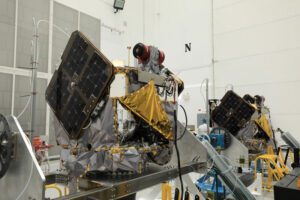NASA and Blue Origin are preparing for the agency’s ESCAPADE (Escape and Plasma Acceleration and Dynamics Explorers) mission, which begins on the inaugural launch of the company’s New Glenn rocket.
The mission will study the solar wind’s interaction with the magnetosphere on Mars.
 Blue Origin is targeting no earlier than Sunday, October 13th, for the launch of New Glenn-1 from Space Launch Complex 36 at Cape Canaveral Space Force Station in Central Florida.
Blue Origin is targeting no earlier than Sunday, October 13th, for the launch of New Glenn-1 from Space Launch Complex 36 at Cape Canaveral Space Force Station in Central Florida.
The ESCAPADE mission will use two identical spacecraft to investigate how the solar wind interacts with the hybrid magnetosphere on Mars and how this interaction drives the planet’s atmospheric escape.
ESCAPADE is the first multi-spacecraft orbital science mission to the Red Planet. Its twin orbiters will take simultaneous observations from different locations around Mars. According to NASA, the observations will reveal the planet’s real-time response to space weather and how the Martian magnetosphere changes over time.
The mission is funded by NASA’s Heliophysics Division and is part of the NASA Small Innovative Missions for Planetary Exploration program.
The ESCAPADE mission is led by the University of California, Berkeley’s Space Sciences Laboratory, and the spacecraft is designed by Rocket Lab. The agency’s Launch Services Program, based at NASA Kennedy, secured the launch service under the VADR (Venture-class Acquisition of Dedicated and Rideshare) contract.


